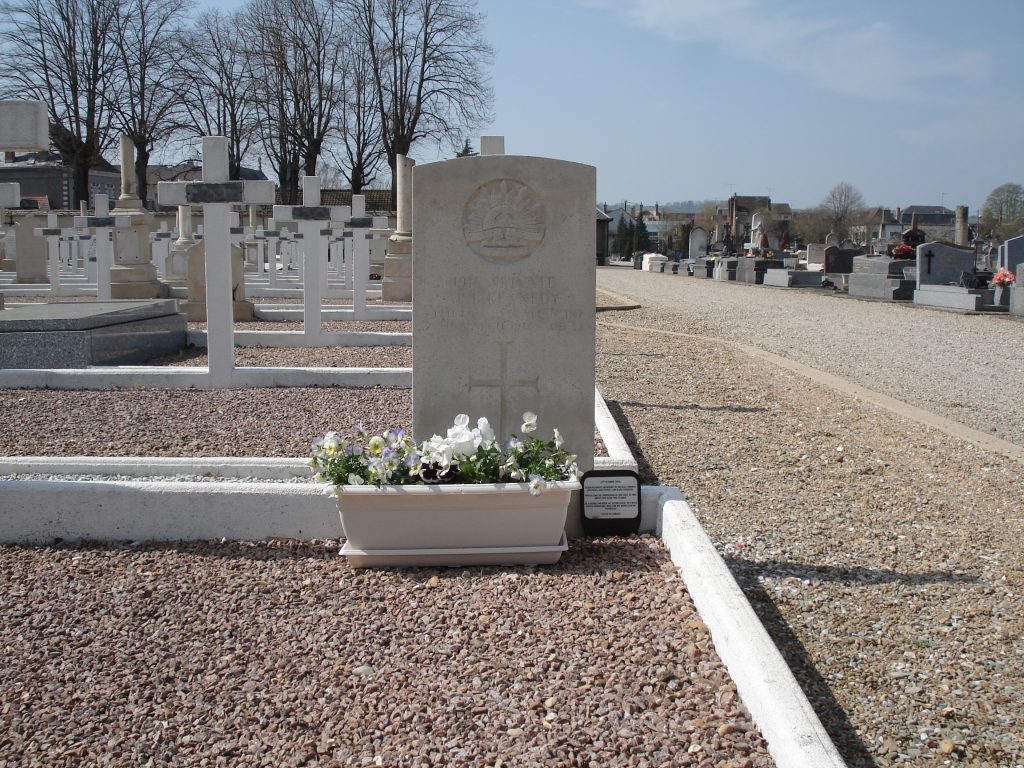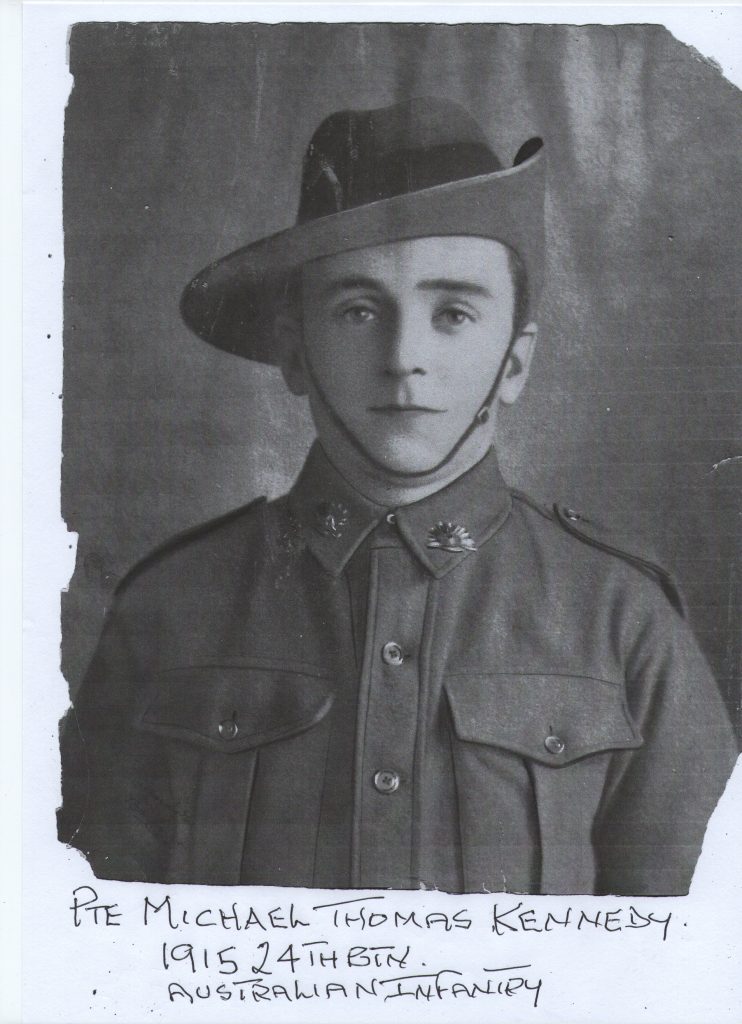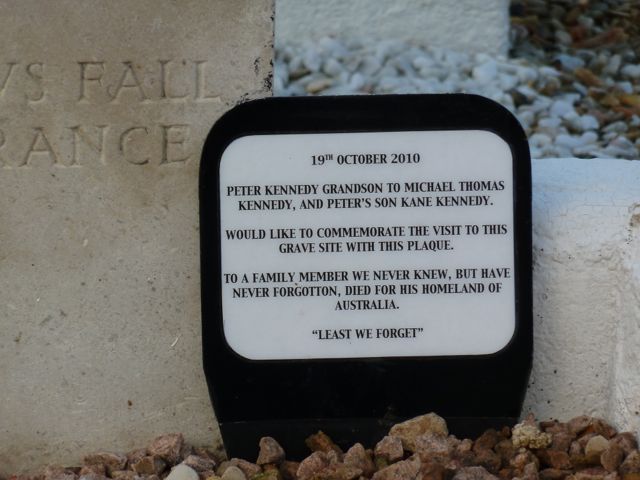‘For Anzac 2023: Michael Thomas Kennedy: from Myall, Victoria, to Sens, France’, Honest History, 24 April 2023
[This article was originally a talk at Alliance Francaise, Turner, ACT, 18 March 2016, to mark the Centenary of the AIF landing at Marseilles, 19 March 1916. Honest History thanks Bill Gammage for providing it to us. HH]
This is Michael Thomas Kennedy. He is a boy here, in a pre-war militia uniform, badges at an odd angle. He enlisted in the AIF on 18 June 1915, the centenary of the battle of Waterloo. He was then 27, with four children, aged two to seven, and a fifth on the way. He was a labourer, probably a farm labourer, from Myall on the Victorian side of the Murray, north of Kerang.
Michael left his children and his pregnant wife, Eva, and went to train at Broadmeadows. Coincidentally, he was allocated the service number 1915, sailed from Port Melbourne with the 3rd reinforcements of 24 Bn, and joined it at Tel El Kebir in Egypt, manning the Suez Canal defences.
24 Bn was part of the Second Division. It was the least disrupted of the four Australian divisions being reorganised in early 1916, so was the first to sail for France. Its 7 Bde HQ and 25 Bn were first to land at Marseilles, on 19 March 1916. Then 24 Bn arrived on 26 March, but the men were kept on the quay under guard, so officially they didn’t see Marseilles – though some did. Late that night, they were loaded onto rail cattle trucks heading north for the Western Front.
They travelled all that night and all the next day and night, until at Paron, just outside Sens-sur-Yonne, at about half past ten on the morning of 28 March, Michael fell underneath the train. Possibly he had hung out to relieve himself; he’d been on the train for 35 hours, and it stopped only about three times every 24 hours or so. His arm was mangled, and he was rushed to a temporary military hospital in Sens, where his arm was amputated. He died about 3.30 next morning, and on 30 March was buried in Sens Communal Cemetery.
Next day, Miss Jenny Lorin of Sens wrote to the Australian Red Cross in London:
An Australian fell from the train here. I look after his tomb, but not knowing of what religion he belonged he had no priest. He died without saying a word after being amputated of an arm. I have put a cross of white violets on his tomb till I know what religion he is. Could you enquire?
 Sens Communal Cemetery (supplied)
Sens Communal Cemetery (supplied)
Michael was Roman Catholic, but I don’t know if Jenny was told that.
The AIF lost touch with Michael’s wife Eva, and in 1918 and 1922 advertised for her. It found her in 1922, in East Melbourne, with three sons and a daughter; the baby had died of diphtheria in July 1921. From when Michael embarked until he died, Eva was owed his allocation to her of 3/5ths of his pay, or 21/- a week; Michael kept 14/-, plus 1/- a day deferred until after the war.
After Michael died, Eva got a pension equalling £2/7/6 a week for herself and four children. Though this was almost certainly more than any private soldier’s widow in any other country, it was not much, and she must have struggled. Michael’s family were war casualties.
One day in June 2010 a Sens resident out walking, Marie-Grace Violetta, sought shade in the cemetery, and found Michael’s grave. It has a typical Commonwealth War Graves headstone, but it is the only one there. Yet it is not alone: it has that pot of white flowers, which I assume Marie-Grace put there, an echo of the white violets Jenny Lorin once laid on the same spot.
Marie-Grace was curious. The cemetery attendant, she says, thought she was crazy, and told her to go to the municipal archives. There she found official details of Michael’s death and burial, but she wanted to know more. She wrote to several people in Australia, including me. I guided her to Michael’s service record in the National Archives.
The record told Marie-Grace of Jenny’s cross of white violets, which struck a chord, because her surname was Violetta. It also told her that Michael and Eva were Victorian, so there was a place to start looking, even for such a common name as Kennedy. Since Eva was last known in East Melbourne, I set to ringing every Kennedy in Melbourne. Sometimes I got puzzlement, sometimes suspicion, but no relatives.
But Marie-Grace found them. At bottom left of the headstone is a small plaque. It was put there in October 2010 by Peter Kennedy, Michael’s grandson, and Peter’s son, Kane. Marie-Grace was away and missed their visit, but when she found the plaque, she checked to see if Peter and Kane had visited the Town Hall. They hadn’t, but the plaque gave her a lead.
 Michael Kennedy’s grave (supplied)
Michael Kennedy’s grave (supplied)
Marie-Grace posted appeals online, and one was answered. Soon emails were going back and forth, and on 12 April 2012 Marie-Grace received some Kennedy family photos, including the one of Michael. In 2016, she kept in regular touch with the family, and still visited Michael’s grave. ‘How wonderful’, she wrote, ‘if Michael could return to Australia, but there are also hundreds of thousands of men and women who never saw their homeland again. If French soil has become his final resting place, then there is a reason for that.’
Because Michael did not return, to most of us he is a soldier forever, but Marie-Grace found a family man, whom his wife loved. Eva named her last baby after Michael, and when asked for an inscription on his grave a decade or so after he died, she paid 16/6, a good part of her small pension, to write,
Time passes, shadows fall,
Love and remembrance outlast all.
*Bill Gammage is Emeritus Professor in the College of Arts and Social Sciences at the Australian National University, Canberra. He has written many articles and many books from The Broken Years: Australian Soldiers in the Great War (1974 and later editions) to The Biggest Estate on Earth: How Aborigines made Australia (2011). Of the above article, he writes: ‘I thank Marie-Grace for most of what is here, and I thank her and Jenny Lorin for their care and respect for the grave of this distant exile’.




Leave a Reply
You must be logged in to post a comment.